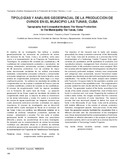| dc.rights.license | http://creativecommons.org/licenses/by-nc-sa/3.0/ve/ | es_VE |
| dc.contributor.author | Herrera-Toscano, Javier Antonio | |
| dc.contributor.author | Carmenate-Figueredo, Oscar | |
| dc.date.accessioned | 2020-04-09T03:33:23Z | |
| dc.date.available | 2020-04-09T03:33:23Z | |
| dc.date.issued | 2020 | |
| dc.identifier.issn | 0798-2259 | |
| dc.identifier.uri | http://www.saber.ula.ve/handle/123456789/46702 | |
| dc.description.abstract | El objetivo de la investigación fue tipificar y analizar
geoespacialmente los escenarios de producción de ovinos
del municipio de las Tunas, Cuba y su periferia, como paso
previo a la implementación de un Programa de Transferencia
Tecnológica. Se analizaron 68 variables (22 cuantitativas y 46
cualitativas) del comportamiento productivo y reproductivo, del
manejo, alimentación, estructurales, sociales y edafoclimáticas
de 49 escenarios productivos. Con las variables de mayor
poder discrimínate resultantes de los análisis previamente
realizados, componentes principales ordinarios y componentes
principales categóricos, se ejecutaron de manera iterativa varios
análisis de conglomerados jerárquicos hasta llegar a la mejor
clasificación posible. Se validaron los resultados del análisis de
conglomerados con las pruebas Ji cuadrado de Pearson .para las
variables cualitativas y análisis de varianza en las cuantitativas.
El proceso de conglomeración rindió los mejores resultados
con la formación de cuatro tipos de fincas. La ubicación
geoespacial de las fincas, según los resultados del análisis de
conglomerado indicó que, la mayoría de estas se encontraron
en las zonas suburbanas y rurales. En cuanto a la existencia
de cuerpos de aguas superficiales, las imágenes revelaron que
cuatro escenarios estuvieron próximos a embalses con alguna
importancia. El proceso de investigación que se desarrolló
permitió definir cuatro tipologías de fincas en el municipio de
las Tunas, Cuba y su periferia, con diferencias notables en la
cantidad de animales, indicadores productivos, aspectos de
manejo - alimentación y sociales. Por otra parte, el análisis
geoespacial facilitó la visualización desde una panorámica
diferente y amplia, las características de la zona investigada.
Se demostró que la complementación de ambas herramientas
constituye una alternativa eficaz en el análisis de sistemas
productivos agropecuarios, que puede ser útil como paso previo a
la implementación de Programas de Transferencia Tecnológicas. | es_VE |
| dc.language.iso | es | es_VE |
| dc.publisher | SaberULA | es_VE |
| dc.rights | info:eu-repo/semantics/openAccess | es_VE |
| dc.subject | Ovinos | es_VE |
| dc.subject | Variables | es_VE |
| dc.subject | Fincas | es_VE |
| dc.subject | Análisis de conglomerados | es_VE |
| dc.subject | Análisis geoespacial | es_VE |
| dc.title | Tipologías y análisis geoespacial de la producción de ovinos en el municipio Las Tunas, Cuba | es_VE |
| dc.title.alternative | Typography And Geospatial Analysis The Sheep Production In The Municipality The Tunas, Cuba | es_VE |
| dc.type | info:eu-repo/semantics/article | es_VE |
| dcterms.dateAccepted | 27/07/2018 | |
| dcterms.dateSubmitted | 16/05/2019 | |
| dc.description.abstract1 | The objective of the research was to typify and analyze
geospatially the sheep production scenarios of the Municipality
of Las Tunas, Cuba and its periphery, as a previous step to the
implementation of a Technology Transfer Program. Sixty eight,
variables (22 quantitative and 46 qualitative) of productive and
reproductive behavior, management, food, structural, social and
edaphoclimatic of 49 productive scenarios were analyzed. With
the variables with the highest discriminating power resulting from
the previously performed analyzes, ordinary main components
and categorical main components, several hierarchical cluster
analyzes were iteratively executed until reaching the best possible
classification. The results of the cluster analysis were validated
with Pearson's Chi-square tests for the qualitative variables and
analysis of variance in the quantitative ones. The conglomeration
process yielded the best results with the formation of four types
of farms. The geospatial location of the farms, according to the
results of the cluster analysis indicated that, most of these were
found in suburban and rural areas. Regarding the existence of
surface water bodies, the images revealed that four scenarios
were close to reservoirs of some importance. The research
process that was developed allowed to define four types of
farms in the Municipality of Las Tunas, Cuba and its periphery,
with notable differences in the number of animals, productive
indicators, management aspects - food and social. On the other
hand, the geospatial analysis facilitated the visualization from a
different and wide view, the characteristics of the investigated
area. It was demonstrated that the complementation of both tools
constitutes an effective alternative in the analysis of agricultural
production systems, which can be useful as a previous step to the
implementation of Technology Transfer Programs. | es_VE |
| dc.description.colacion | 186-191 | es_VE |
| dc.description.email | Jherrera@ica.co.cu | es_VE |
| dc.identifier.depositolegal | pp199102ZU46 | |
| dc.identifier.edepositolegal | ppi201502ZU4665 | |
| dc.identifier.eissn | 2477-944X | |
| dc.publisher.pais | Venezuela | es_VE |
| dc.subject.institucion | Universidad del Zulia (LUZ) | es_VE |
| dc.subject.institucion | Universidad de Los Andes (ULA) | es_VE |
| dc.subject.publicacionelectronica | Revista Científica | |
| dc.subject.seccion | Revista Científica: Producción Animal | es_VE |
| dc.subject.thematiccategory | Medio Ambiente | es_VE |
| dc.subject.tipo | Revistas | es_VE |
| dc.type.media | Texto | es_VE |


